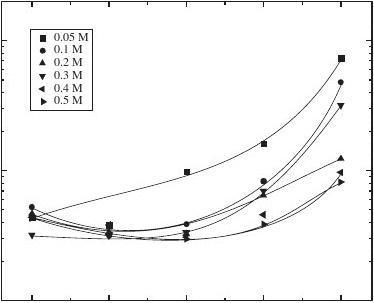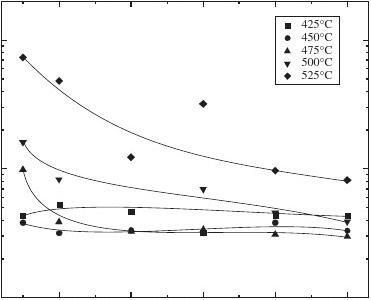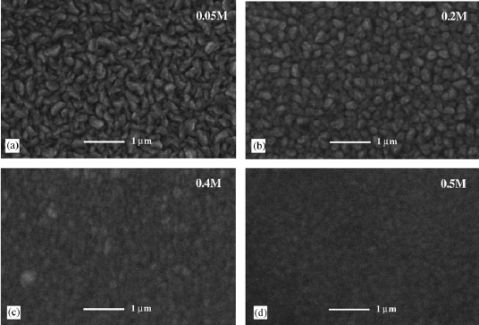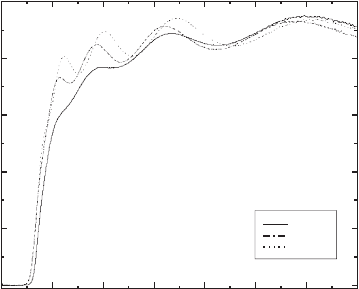ZnO制备实验报告
纳米氧化锌的制备
实验报告
班级:应091-4
组号:3
组员:付嫱 200921501410
贡文秀 200921501411
郭鑫 200921501412
指导老师:翁永根
2012.3
一、实验目的
1.了解ZnO的广泛用途,良好性能及主要应用;
2.初步学会ZnO的评价和表征;
3.掌握从硫酸锌溶液中,除去铁、铜、镍和镉等杂质离子的原理和方法;
4.运用无机化学基本原理和知识,查阅相关资料,提高综合运用所学知识解决实际问题的能力;
5.初步了解ZnO的工业生产并培养经济成本意识和环保意识。
二、实验原理
氧化锌(ZnO),俗称锌白,相对分子质量81.39,是锌的一种氧化物,白色或浅黄色微细粉末。难溶于水,可溶于酸和强碱。氧化锌是一种常用的化学添加剂,易分散在橡胶和乳胶中,是天然橡胶、合成橡胶的补强剂,活性剂及硫化剂,也是白色胶料的着色剂和填充剂。胶料中加入活性氧化锌后,能使橡胶具有良好的耐磨性,耐撕裂性和弹性。在化妆品中添加活性氧化锌,既能屏蔽紫外线起到防晒作用,又能抗菌除臭。因此氧化锌广泛地应用于塑料、硅酸盐制品、合成橡胶、润滑油、油漆涂料、药膏、粘合剂、食品、电池、阻燃剂等产品的制作中。
氧化锌的能带隙和激子束缚能较大,透明度高,有优异的常温发光性能,在半导体领域的液晶显示器、薄膜晶体管、发光二极管等产品中均有应用。此外,微颗粒的氧化锌作为一种纳米材料也开始在相关领域发挥作用。
活性氧化锌和普通氧化锌在化学成分上是相同的,它们的差异主要表现在物理性质上。活性氧化锌具有力度小、比表面积大、荧光性、压电性以及较强的吸水性和散射紫外线能力等许多独特的物理、化学性质,因此显示出优越的性能和广泛的应用前景。
氧化锌的制备方法有很多,工业上常用氢氧化锌、碳酸锌或碱式碳酸锌分解法。本实验以锌焙砂(主要成分为氧化锌、锌并含有少量铁、铜、铅、镍、镉等杂志,杂志均以氧化物形式存在)和硫酸为主要原料,制备七水合硫酸锌,以碳酸氢铵为沉淀剂,采用碱式碳酸锌分解法制备活性氧化锌。
硫酸锌或ZnO含量采用配位滴定法测定,用NH3-NH4Cl缓冲溶液控制溶液pH值约为10,以铬黑T为指示剂,用EDTA标准滴定溶液进行滴定,其主要反应如下:
在氨性溶液中:
Zn2++4NH3DZn(NH4)4 2+
加入EBT(铬黑)
Zn(NH4)4 2+ +EBT(蓝色)DZn-EBT(酒红色)+ 4NH3
滴定开始~计量点前:
Zn(NH4)4 2++EDTADZn-EDTA+ 4NH3
计量点时:
Zn-EBT(酒红色) +EDTAD Zn-EDTA+EBT(蓝色)
三、实验仪器试剂
1.仪器
分析天平、电子天平、烧杯、洗瓶、玻璃棒、滤纸、抽滤装置、pH试纸(1~14)、
蒸发皿、表面皿、锥形瓶(250ml)、石棉网、电炉、水浴锅、烘箱、锥形瓶、容量瓶、胶头滴管、碱式滴定管、筛子
2.试剂
锌焙砂10g、H2SO4 (3mol/L)、HCl(6mol/L)KMnO4 (0.1mol/L)、锌粉0.1g、NH4HCO3 (s)、氧化锌粉末、EDTA二钠盐标准滴定溶液、铬黑T指示剂、NH3?H2O、NH3-NH4Cl缓冲溶液、Ag、AgNO3、水合肼、凡士林、TiO2、CaCO3、滑石粉
四、实验步骤
1.酸解
(1)称取10g锌焙砂于锥形瓶中,加入35ml 3mol/L的 H2SO4 ;
(2)放在80℃水浴锅中加热约50min,加热过程中隔二三分钟摇晃锥形瓶,直至锥形瓶中有极少量残渣,反应停止;
(3)加15ml去离子水,加热煮沸后过滤,若滤纸上还有未反应完的原料,称重并记录数据
2.除Fe
(1)在硫酸锌溶液(粗溶液)中滴加0.1mol/L的KMnO4至颜色不再消失为止;
(2)调节pH值:加入0.5g左右氧化锌粉末,至用pH试纸测得溶液pH达到4~5,加入的氧化锌粉末要计量称重;
(3)溶液煮沸3min后,减压过滤;
3.除重金属
(1)过滤后的溶液加入锌粉0.1g;
(2)80℃水浴锅加热,不断搅拌10min;
(3)过滤;
4.制备ZnO
(1)在上述溶液中加入蒸馏水稀释至100ml,然后在低于35℃下,加入9g NH4HCO3 (分批加入),不断搅拌10min;
(2)减压过滤,充分洗涤滤饼;
(3)将洗涤后的滤饼在烘箱内240℃烘干;
(4)将干燥后的半成品放入高温炉里煅烧2h;
(5)去除成品氧化锌,冷却至室温,称重;
5.定量分析
产品含量的测定:精确称取0.40~0.41g产品ZnO,用6mol/L的HCl溶解,然后定容至250ml容量瓶中,取25ml溶液,用10%氨水调pH值7~8,加入NH3-NH4Cl缓冲溶液调pH≈10,加入两滴铬黑T指示剂,摇匀,用用已经标定好的EDTA溶液滴定至终点,平行测定两次,同时做空白试验。
6. ZnO的用途
(1)除异味的药水
称取一定量的ZnO产品,按照ZnO:Ag为50:1的比例加入0.05mol/L AgNO3 溶液,水浴上挥发至干,然后加入3ml水合肼,水浴挥发至干,得到干的产品,即ZnO表面附上了一层银。
用得到的产品配成5%的水溶液,即得到除异味的药水。
(2)治疗脚气的药膏
用前一步得到的一定量的产品与凡士林混合,得到治疗脚气的药膏。
(3)防晒粉
按照ZnO:TiO2:CaCO3:滑石粉为0.4:0.6:1:3的比例混合后,在研钵里研磨几分钟,然后过筛,得到防晒粉。
五、实验现象及数据记录
1.实验数据记录及处理
(1)ZnO的制备

产量计算:m(ZnO)=m(产品)-m(添加ZnO)
=(2.19-2.0)g
=0.19g
m(锌焙砂)实=m(锌焙砂)—m(杂质)
=(10.0-0.45)g
=9.55g
产率= m(ZnO)/m(锌焙砂)实×100%
=0.19/9.55×100%
=1.68%
(注:半成品氧化锌ZnO在高温炉里煅烧时盛放在表面皿里在加热过程中炸裂,向外取的过程中洒在了地上,致使产品大量减少)
(2)ZnO含量的测定
mZnO=0.4004g
CEDTA=0.01795mol/L

根据ZnO:EDTA=1:1
VEDTA平均=1/2×(26.25+26.30)—0.05=26.23ml
mZnO纯=81.39×(0.01795×26.23×10-3)×10=0.3832g
ZnO含量=0.3832/0.4004×100%=95.70%
(3) ZnO的应用
制备脚气治疗产品及除异味用液体喷剂:
mZnO=1.36g
V(AgNO3溶液(0.05mol/L))=7.25ml
V(水合肼)=3ml
制备防晒粉:
mZnO=0.4025g mTiO2=0.6055g
mCaCO3=1.0g m滑石粉=3.0g
2.实验现象记录

六、注意事项
(1)蒸馏水的质量是否符合要求,是配位滴定应用中十分重要的问题:
①若配制溶液的水中含有Al3+、Cu2+等,就会使指示剂受到封闭,致使终点难以判断;
②若水中含有Ca2+、Mg2+、Pb2+、Sn2+ 等,则会消耗EDTA,在不同的情况下会对结果产生不同的影响。因此,在配位滴定中,必须对所用的蒸馏水的质量进行检查,为保证质量,经常采用二次蒸馏水或去离子水来配制溶液。
(2)EDTA溶液应当贮存在聚乙烯塑料瓶或硬质玻璃瓶中,若贮存于软质玻璃瓶中,会不断溶解玻璃中的Ca2+ 形成CaY2- ,使EDTA的浓度不段降低。
(3)金属指示剂往往是有机多元弱酸或弱碱,兼具pH指示剂之功能,因此,使用时必需注意选择合适的pH范围。
七、思考题
1.用KMnO4溶液除铁过程中,理论上PH应控制在什么范围?你认为在实际生产过程中应控制在什么范围?若溶液PH低于或高于你想要的PH范围,应如何处理?
答:

理论上要使Fe3+完全沉淀而Zn2+不至于形成沉淀,pH应控制在3.2~5.28之间。实际生产中PH应控制在5.0~5.4;因为酸度太高会严重腐蚀生产设备。若溶液的pH低于想控制的范围可以加入适量 的ZnO调节,若高于想控制的范围,可加入适量的稀硫酸调节。
2. KMnO4的量如何控制?若不小心加入的KMnO4过量太多,应如何处理?
答:在Zn2SO4粗溶液中逐滴加入KMnO4溶液并震荡,滴至溶液呈微红色。若不小心加入的KMnO4过量太多,应加入适量的H2O2,发生反应:
2 MnO4-+5 H2O2+6H+→5O2↑+2Mn2++8H2O
3.除铁过程中是否需要加热?原因何在?
答:需要。因为氢氧化铁胶体抽滤时易堵塞滤纸,加热可使氢氧化铁聚沉。
4.用KMnO4氧化Fe2+为Fe3+时,在酸性和微酸性条件下,反应产物是否一样?是写出它们的反应式。
答:反应产物不一样。
在酸性条件下:5Fe2+ + MnO4- + 8H+ =5Fe3+ + Mn2+ + 4H20
在微酸性条件下:3Fe2+ + MnO4- + 4H+ =3Fe3+ + MnO2 + 2H2O
5. 如何定性鉴定硫酸锌溶液中是否存在Fe2+(或Fe3+)和Mn2+?
答:Fe2+,Fe3+:滴加稀HNO3酸化,加入KSCN溶液,如果变为红色,存在Fe2+或Fe3+。
6.用锌粉置换法除去硫酸锌溶液中的Cu2+、Cd2+和Ni2+时,如果检验Ni2+已除尽,是否可以认为Cu2+、Cd2+也已除尽?
答:查表比较EZn2+/Zn、ECd2+/Cd、ENi2+/ni、ECu2+/Cu的大小,就能看出锌粉加入后能否除去杂质。然后再从组成原电池E的比较、确定离子的还原次序。
查表得:E(Zn2+/Zn)= 0.7628 V ;E(Cd2+/Cd) = 0.4026 V ;E(Ni2+/Ni) = 0.23 V E(Cu2+/Cu)= +0.3402 V
从标准电极电位的数值可知:E(Zn2+/Zn)<E(Cd2+/Cd)<E(Ni2+/Ni)<E(Cu2+/Cu)
这里锌为较强的还原剂,而Cd2+、Ni2+、Cu2+为较强的氧化剂,所以下列除杂离子的氧化还原反应是可以进行的。
Zn + Cd2+ = Zn2+ + Cd
Zn + Ni2+ = Zn2+ + Ni
Zn + Cu2+ = Zn2+ + Cu
同时反应后Zn变为Zn2+ 离子,又不引进新的杂质,因此用锌粉除杂质离子是较理想的。
由于杂质离子含量相同,可用标准电极电位来判断离子的还原次序。
在铜锌电池中 EMF = E (Cu2+/Cu)- E(Zn2+/Zn )= 0.3402-( -0.7628)= 1.1030 V,在镍锌电池中 EMF= E(Ni2+/Ni)- E(Zn2+/Zn) = 0.23 -(- 0.7628)= 0.5328 V。
在镉锌电池中 EMF= E(Cd2+/Cd)-E(Zn2+/Zn)= 0.4026 -(- 0.7628)= 0.3602 V
EMF铜锌电池>EMF镍锌电池>EMF镉锌电池
所以Zn首先还原Cu2+,其次才是Ni2+、Cd2+,故还原次序为Cu2+、Ni2+、Cd2+。因此检验Ni2+已除尽,不可以认为Cu2+、Cd2+也已除尽。
7.EDTA配位滴定中为什么要使用缓冲溶液?多加缓冲溶液对测定有影响吗?
答:为了控制溶液pH,因为有H+释放,使得H+浓度升高,降低了络合物的条件稳定系数,滴定突越变小,破坏了指示剂变色的最适酸度。所以要加缓冲溶液。若多加缓冲溶液则会影响指示剂到达终点时的灵敏度。
8.在配位滴定中,指示剂应具备什么条件?
答:金属指示剂一般是具有酸碱指示剂性质的染料,同时又是一种配位剂,能与金属离子形成一种与染料本身颜色明显不同的配合物,从而指示滴定终点。
(1)配合物的颜色与指示剂本身必须明显不同
(2)配合物的稳定性要适中
(3)配合物最好能有较好的水溶性
(4)指示剂与金属离子的反应必须迅速,并具有良好的可逆性
9.怎么用氨水溶液(10%)调节溶液PH至7~8?
答:Zn2+和氨水生成了络合物,所以看不到白色沉淀。沉淀要在PH=7左右才会出现,所以滴加氨水的时候速度要慢,要一滴一滴的加,这样才可以看到白色沉淀,继续滴加,当沉淀会消失,PH就已调节到7~8。
10,工业中选取缓冲剂的选择所要考虑的问题?
(1)安全环保
(2)成本核算
(3)考虑缓冲剂是否简易操作,安全。
八、总结
1.实验经济成本计算
按照实验室中的合成过程,将其放大一万倍计算成本如下:
原料成本:锌焙砂10.0g×10000×4元/Kg=400元
H2SO4、HCl、KMnO4、锌粉、NH4HCO3、氧化锌粉末、EDTA二钠盐标准滴定溶液、铬黑T指示剂、NH3?H2O、NH3-NH4Cl缓冲溶液、Ag、AgNO3、水合肼、凡士林、TiO2、CaCO3、滑石粉等等算为100元
水电消耗:水费=0.5t×3元/t=1.5元
电费=5度×1.0元/度=5元
劳动力报酬:6.3元/h×8h×3人=151.2元
收益:3.5g×10-3×10000×25元/kg=875元
利润=收益-原料成本-水电消耗-劳动力报酬=875-400-1.5-5-151.2=317.3元
2.感悟
(1)在除铁的时候,滴加的氧化剂理论上比Eθ(Fe3+/Fe2+)的电动势高就可以工业生产中用H2O2,无任何副产物,而且安全环保、效率高,但是在实验室中终点颜色判断不明显,在实验室还可以用重铬酸钾、O3、Cl2、HClO4、HNO3、CrO2,但是重铬酸钾、CrO2中的铬有毒,具有致癌作用,HClO4 易爆炸,HNO3 产生氮氧化物,污染大气,本实验用的是KMnO4。
(2)除铁过程中调节pH值时,若使用氨水,不仅具有臭味,而且易造成局部温度过高,造成Zn(OH)2沉淀或络合物;本实验加入ZnO和H2SO4反应,当pH达到4~5时(用pH试纸检测),ZnO不与H2SO4 发生反应,Fe在pH=2.6时开始沉淀,从而可以出去溶液中的Fe。
(3)通过本实验初步了解到了工业生产与实验室做实验的差别,实验室注重的是结果,但是在工业生产中要考虑多方面因素,例如成本、环保的问题。
九、附表(产品照片)

第二篇:ZnO_In 薄膜的制备



Correspondingauthor.Tel.:525550613784;fax:525550613978.E-mailaddress:molvera@cinvestav.mx(M.delaL.Olvera).
734′pezetal./SolarEnergyMaterials&SolarCells90(2006)733–741M.A.Lucio-Lo
1.Introduction
Zincoxide(ZnO)thin?lmsareattractiveinthesemiconductors?eldduetotheirgoodopticalcharacteristics,highstabilityandexcellentelectricalproperties,amongothers[1–4].Theyhavebeenfrequentlyusedinseveralelectronicapplicationssuchastransparentconductingmaterials[5–7],piezoelectrictransducers[8],solarcells
[9–12],surfaceacousticwave?lters[13],heatmirrors[14],andliquidcrystaldisplays
[15].Inadditiontotheirpotentialinoptoelectronicdevices,nowadaystheyhavebeingappliedasgaschemicalsensorsasaresultoftheirhighsurfacesensitivitywiththetypeandconcentrationofthesurroundingatmosphere[16–18].
Differentdepositiontechniqueshavebeenwidelyusedtoproducesemiconductorthin?lms.However,searchingthemostreliableandeconomicdepositiontechniqueisthemaingoal.Amongthemoststudiedtechniquesarethereactiveandnon-reactivesputtering[19,20],chemicalvapordeposition[21,22],oxidationofanevaporatedmetallic?lm[23]andanumberofchemicaltechniques[24–31].Theyhavebeenstudiedintensivelyinthelastthreedecadesduetotheirsimplicityandeconomy.Thechemicalbathdeposition,chemicalspray,andsol–geltechniquesarewellknownforthepreparationofthin?lms.
Thechemicalspraytechniqueisanexcellentmethodforthedepositionofthin?lmsofmetallicoxidesasisthecaseofZnOmaterial.Inthisdepositiontechnique,astartingsolution,containingtheZnanddopantprecursors,issprayedbymeansofanozzle,assistedbyacarriergas,overahotsubstrate.Whenthe?nedropletsarriveatthesubstrate,thesolidcompoundsreacttobecomeanewchemicalcompound.Thequalityandthephysicalpropertiesofthe?lmsdependonthedepositionparameters,suchassubstratetemperature,molarconcentrationofthestartingsolution,sprayrate,typeandrateofcarriergasandgeometriccharacteristicsofthespraysystem.
Inthiswork,theelectrical,structural,morphologicalandopticalpropertiesofindium-dopedZnOthin?lmsdepositedbythechemicalspraytechniqueatdifferentsubstratetemperatures,usingstartingsolutionswithdifferentmolarconcentrations,arereported.Therestofthedepositionparameterswere?xedinordertoobtainZnO?lmswithlowresistivityandhighopticaltransmittanceinthevisibleregion.
2.Experimentalprocedure
ZnOthin?lmswerepreparedbychemicalsprayusingastartingsolutionwithdifferentmolarconcentrations(0.05,0.1,0.2,0.3,0.4and0.5M)andsubstratetemperatures(425,450,475,500and5251C).Zincpentanedionateandindiumchloridewereemployedaszincandindiumprecursors,respectively.Inthiswork,aconstantatomicratio[In/Zn]of3at%wasused.Thesolventconsistedofa2.5:1:6.5mixtureofdeionizedwater,aceticacidandmethanol,respectively.TheZnOthin?lmsweredepositedontosoda-limeglasssubstrates,cleanedpreviously,whichwereheatedbyanelectricalresistancecontrolledelectronicallywithanaccuracyof711C.Thesolutionandgasnitrogen?owrateswerekeptconstantat12ml/minand
′pezetal./SolarEnergyMaterials&SolarCells90(2006)733–741M.A.Lucio-Lo735
10l/min,respectively.Thethicknessofthe?lmswasmeasuredbyaDEKTAKIIpro?lmeter;all?lmswere0.55mmthick,approximately.Theelectricalmeasurementswereperformedusingthefour-pointmethod.Thecrystallinestructureandthepreferredorientationsoftheprepared?lmswereanalyzedbyX-raydiffractionpatternsobtainedfromaSiemensKristallo?exdiffractometer,usingtheCu-Karadiation(l?0:1534nm).OpticaltransmittancedatawereobtainedfromanUV–visible2401PCShimadzuSpectrophotometerinawavelengthrangeof300–1000nm.Surfacemorphologyofthe?lmswasobservedusingascanningelectronicmicroscopeJEOL35C.
3.Resultsanddiscussion
3.1.Electricalcharacterization
Fig.1showstheeffectofthedepositiontemperatureontheelectricalresistivityofZnO:Inthin?lms,for?lmsdepositedfromstartingsolutionswithdifferentmolarconcentrations.Ascanbeseenfromthis?gure,aminimumresistivityvaluearoundof3?10à3Ocmisobtainedfor?lmsdepositedat4751Cfroma0.5Mstartingsolution.Filmsdepositedatlowsubstratetemperatures(425–4751C)andmolarconcentrationshigherthan0.05Mpresentresistivityvalueswithsmallvariations.However,athighersubstratetemperatures(500and5251C),theeffectofthemolar
10-1Resistivity (?cm)10-2
10-3
425450475500525
Substrate Temperature (°C)

Fig.1.ResistivityvariationasafunctionofthesubstratetemperatureforZnO:Inthin?lms,depositedfromstartingsolutionswithdifferentmolarconcentrations:0.05,0.1,0.2,0.3,0.4and0.5M.
736′pezetal./SolarEnergyMaterials&SolarCells90(2006)733–741M.A.Lucio-Lo
concentrationontheelectricalpropertiesisevident,mainlyforthe0.05M?lms,whichpresentthehighestvariation.Thisresistivityrisecanbeattributedtotwofactors,the?rstoneisrelatedwiththediffusionofalkalineimpuritiescomingfromtheglasssubstrate,whichiscommoninthechemicalspraytechniqueathighsubstratetemperatures,andthesecondfactoristhemorede?nitestoichiometryofthe?lm,asaconsequenceofthelongerresidencetimeofthereactantsonthesubstrate;hence,thereactionformationismorecomplete.TheseresultsshowthesuccessoftheindiumdopingoverothergroupIIIelements,asneitherannealingtreatmentnorhighsubstratetemperaturesarerequiredinordertoobtainlow-resistivity?lms.Thislastcharacteristicmightbebene?cialinthecaseofthosedevicesrequiringa?nalthermalprocessnotcausingsurfacedamage.
Fig.2showsthesameelectricalcharacterizationshowninFig.1withotherpresentation,inordertohaveabetterunderstandingoftheresistivitydependencewiththemolarconcentration.Itisevidentthatlowmolaritiesleadtohigherresistivityvalues.Thisfactismorenoteworthyathighsubstratetemperaturesfortheabovereasons.
FromHalleffectmeasurements,usingtheVanderPawmethod[32],thecarrierconcentrationsandtheelectronicmobilitiesweredetermineed.Thelargestmobilityvalue,around3cm2/Vs,wasobtainedfor?lmsdepositedundertheoptimaldepositionconditions(at4751Cfroma0.5Msolution),whereasthecarrierconcentrationsrangedfrom6to9?1020cmà3.
10-1Resistivity (?cm)10-2
10-3
0.10.20.30.40.5
Molar Concentration (M)

Fig.2.ResistivityvariationasafunctionofthemolarconcentrationofthestartingsolutionsofZnO:Inthin?lms,depositedatdifferentsubstratetemperatures:425,450,475,500and5251C.

3.2.Structuralcharacterization
TheX-raydiffractionpatternsofthe?lmsareassembledinFig.3.AllthespectracorrespondtoZnO:In?lmsdepositedat4751C,whichweconsideristhemostreliabletemperaturetoobtaingood-quality?lms,atleastinthiswork.Itisreadilyobservedthatallthespectrapresentanimportantnoisesignalinthebaseline,asaconsequenceofbothfastscanningperformedandthepoorcrystallinityofthe?lms.

738′pezetal./SolarEnergyMaterials&SolarCells90(2006)733–741M.A.Lucio-Lo
Itisevidentthatallthe?lmsarepolycrystalline,andinalmostallthecasesthespectraexhibitedapreferredorientationalong(101),exceptforthe0.1M?lm,whichpresentsthe(002),(101),(102)and(103)re?ectionswithsimilarintensity,andthe0.5M?lm,whichshowsanalmostsimilarintensityinthe(100)and(101)directions.Thepositionofthepeaks?tswellwiththehexagonalwurtzite-typestructureofZnO[33].
3.3.Morphologicalcharacterization
FourSEMimagesforZnO:In?lmsgrownat4751Cfrom0.05,0.2,0.4and0.5MstartingsolutionsareshowninFig.4.Anevidentchangeinthegrainmorphologiesduetotheeffectofthemolaritycanbeobserved.Allimagesshowagooduniformityandadensesurfacewithoutvisibleholesorfaultyzonesonthe?lmsurface.Inaddition,thedensityofthefeaturesincreasesasthemolarconcentrationincreases.The?rstSEMimage(Fig.4a),correspondingtothelowestmolarconcentrationused(0.05M),exhibitsagranularsurfaceintheformofdendrite-likegrainsofsize400?300nm.The0.2M?lms(Fig.4b)presentalmostspherical-shapedgrainswithadiameteroftheorderof250–300nm.For0.4M?lms,amorecompactedandsmootherwithoutevidentgrainboundariesisobserved(Fig.4c).Highermolarconcentrationsleadtotheformationof?lmswithbiggersmoothness(Fig.4d).Fig.4.SEMmicrographsofZnO:Inthin?lmsdepositedat4751Cfrom0.05,0.2,0.4,and0.5Mstartingsolutions.
′pezetal./SolarEnergyMaterials&SolarCells90(2006)733–741M.A.Lucio-Lo739
3.4.Opticalcharacterization
Fig.5showstheopticaltransmittancespectraforwavelengthsof300–1000nmforZnO?lmsdepositedat4751CfromstartingsolutionscontainingZnmolarconcentrationsof0.05,0.4and0.5M.Thespectrashowexcellenttransmissioninthevisiblerange(480%)andasharpcut-offbetween353and360nm.Fromthesespectra,wecanobservethatthemolarconcentrationslightlyaffectsthetransmittanceofthe?lms.Anestimationoftheopticalbandgap,Eg,waspossiblebyanextrapolationofthelinearportioninaplotofehnaT2againsthn,whereaistheopticalabsorptioncoef?cient(calculatedase1=dTlne1=TT;d:thickness?lm,andT:opticaltransmittance)andhnisthephotonenergy.Thisestimationprocedureiswidelyusedfordirecttransitionsemiconductors,whichobeysthefollowingrelation[34]:
eahnT2$ehnàEgT.
TheEgvalueswereintheintervalof3.42–3.54eV.Accordingwiththisvariationwecanconsiderthattheopticalpropertiesofthe?lmsdepositedwerenotaffectedbyusingdifferentmolarconcentrationinthestartingsolutions,implyingwiththeseresultsthatthebasiccrystallatticesofZnO?lmsarenotsigni?cantlymodi?ed.
100
80
Transmittance (%)

6040
200300400500600700
Wavelength (nm)8009001000
Fig.5.OpticaltransmittancespectraforZnO:Inthin?lmsdepositedat4751Cfrom0.05,0.4and0.5Mstartingsolutions.
740′pezetal./SolarEnergyMaterials&SolarCells90(2006)733–741M.A.Lucio-Lo
4.Conclusions
Transparentconductinganduniformindium-dopedZnOthin?lmswerepreparedbyspraypyrolysis,usingzincpentanedionateandindiumchlorideasprecursors.Itisshownthatthechemicalspraytechniqueisasef?cientandreliableasanothersophisticatedgrowthtechnique.Theminimumelectricalresistivityvalueoftheorderof3?10à3Ocmwasobtainedin?lmsdepositedat4751Cfroma0.5Mstartingsolution.Accordingwithourresults,weconsiderthattheelectricalresistivityislimitedbythesmallgrainsizepresentedintheZnO:In?lmsprepared.X-raystudiesshowa(101)textureinalmostallcases,exceptin?lmsdepositedfroma0.5Msolution,whichpresenttwomainpreferredorientations,(100)and(101);andthe0.1M?lm,whichpresentsthe(002),(101),(102)and(103)re?ectionswithsimilarintensity.Filmsdepositedatlowmolarconcentrationshowwell-de?nedgrains;however,highmolarconcentrationsleadtoamoreuniformandsmoothersurface.Theopticaltransmittanceandtheadsorptionband-edgearenearlyconstantasthesubstratetemperatureandmolarconcentrationwerevaried.Bandgapvaluesinanintervalof3.42–3.54eVwerecalculatedforthe?lmsreportedinthiswork.
ThepresentworkencouragesustofutureinvestigationsabouttheeffectoftheindiuminZnOthin?lmsaswellasforthestudyofotherdopants,asisthecaseofanionicimpurities.Nevertheless,theresultspresentedarenotthemostextensivereported,weconsideredthatthese?lmsarepotentiallyattractivetobeappliedastransparentconductorsinthin?lmsolarcells.
Acknowledgments
n,A.Palafox,M.Guerrero,andG.Lopez-TheauthorsacknowledgeM.Galva
nforthetechnicalassistance.ThepartialeconomicalsupportbyConsejoFabia
NacionaldeCienciayTecnolog?a(CONACyT)throughtheGrant39487isalsogratefullyacknowledged.
References
[1]
[2]
[3]
[4]
[5]
[6]
[7]
[8]
[9]
[10]
[11]
[12]M.Krunks,E.Mellikov,ThinSolidFilms270(1995)33.LeeChanghyun,LimKoengsu,SongJinsoo,Sol.EnergyMater.Sol.Cells43(1996)37.S.Major,S.Kumar,M.Bhatnagar,K.L.Chopra,Appl.Phys.Lett.49(1986)394.M.delaL.Olvera,A.A.Maldonado,R.P.Asomoza,ThinsolidFilms229(1993)194.P.S.Patil,Mater.Chem.Phys.59(1999)185.J.McK.Nobbs,F.C.Gillespie,J.Phys.Chem.Solids31(1970)2353.A.Maldonado,M.delaL.Olvera,S.Tirado-Guerra,R.Asomoza,Sol.EnergyMater.Sol.Cells82(2004)75.L.B.Wen,Y.W.Huang,S.B.Li,J.Appl.Phys.62(1987)2295.A.Smith,ThinSolidFilms376(2000)47.P.Nunes,B.Fernandes,E.Fortunato,P.Vilarinho,R.Martins,ThinSolidFilms337(1999)176.A.L.Dawar,J.C.Joshi,Mater.Sci.19(1984)1.H.Nato,S.Tsubakino,T.Kawi,M.Ikeda,S.Kitagawa,M.Habara,J.Mater.Sci.29(1994)6529.
′pezetal./SolarEnergyMaterials&SolarCells90(2006)733–741M.A.Lucio-Lo
[13]
[14]
[15]
[16]
[17]
[18]
[19]
[20]
[21]
[22]
[23]
[24]
[25]
[26]
[27]
[28]
[29]
[30]
[31]
[32]
[33]
[34]741Y.Nakagawa,Appl.Phys.Lett.31(1977)56.Y.L.Min,Ph.D.Thesis,StateUniversity,NewBrunswick,NJ,USA,1987.K.L.Chopra,S.Major,D.K.Pandya,ThinSolidFilms102(1983)1.T.Seiyama,A.Kato,K.Tujiishi,M.Nagatani,Anal.Chem.34(1962)1502.M.delaL.Olvera,R.Asomoza,SensorActuatorB45(1997)49.S.Matsuura,SensorActuatorB13–14(1993)7.T.Minani,T.Yamamoto,T.Miyata,ThinSolidFilms366(2000)63.E.M.Bachari,G.Baud,S.BenAmor,M.Jacquet,ThinSolidFilms348(1999)165.K.Kobayashy,T.Matsubara,S.Matsushima,S.Shirakata,S.Isomura,G.Okada,ThinSolidFilms266(1995)106.R.Groenen,J.Lo?er,P.M.Sommeling,J.L.Linden,E.A.G.Hamers,R.E.I.Schropp,M.C.M.vandeSanden,ThinSolidFilms392(2001)226.MaJin,JiFeng,MaHong-lei,LiShu-ying,J.Vac.Sci.Technol.A13(1995)92.R.Ayouchi,D.Leinen,F.Martin,M.Gabas,ThinSolidFilms426(2003)68.M.Miki-Yoshida,F.Paraguay-delgado,W.Estrada-Lopez,ThinSolidFilms376(2000)99.G.K.Paul,S.Bandyopadhyay,S.K.Sen,Mater.Chem.Phys.79(2003)71.T.Schuler,M.A.Aegerter,ThinSolidFilms351(1999)125.ndez-Lira,Sol.EnergyMater.Sol.Cells71M.delaL.Olvera,A.Maldonado,R.Asomoza,M.Mele(2002)61.T.Schuler,M.A.Aegerter,ThinSolid?lms351(1999)125.,M.Troyon,M.Amrani,Mater.Chem.A.ElHichou,M.Addou,A.Bougrine,R.Dounia,J.EbothePhys.83(2004)43.Y.Natsume,H.Sakata,ThinSolidFilms372(2000)30.Lookwww.eeel.nist.gov/812/hall.html.PowderDiffractionFile,DataCard5-644,3cPDSInternationalCenterforDiffractionData,Swartmore,PA.+6.P.SreedharaReddy,etal.,SolidStateCommun.12(1991)899.
-
金相试样制备试验报告
金相试样的制备一实验目的1了解金相显微试样制备原理熟悉金相显微试样的制备过程2初步掌握金相显微试样的制备方法二实验原理金相试样制备…
-
金相显微镜的使用及金相试样的制备实验报告
实验1金相显微镜的使用及金相试样的制备一实验目的1掌握金相试样制备的基本方法2掌握金相显微镜的使用方法二原理概述一金相显微镜的构造…
-
金相显微镜的使用与金相样品的制备实验报告
金相显微摄像一实验目的一了解普通金相显微镜的构造与使用方法二了解金相试样的制备方法三学习使用金相显微镜观察金相组织二实验设备及材料…
-
金相试验实验报告
中北大学材料科学与工程学院实验报告实验报告班级姓名学号中北大学材料科学及工程学院实验中心中北大学材料科学与工程学院实验报告一实验名…
-
金相制备报告
金相试样的制备实验报告学院电气与控制工程学院班级电气1202班姓名刘贝学号120xx60208金相试样的制备一实验目的1熟悉金相显…
-
区发改局20xx年半年社会发展工作总结
20xx年半年社会发展工作总结20xx年x月今年以来,紧紧围绕市“三争一创”的总体要求和区委、区政府“创新提升年”决策部署,以打造…
-
荣成市第三人民医院安全生产月活动总结
荣成市第三人民医院安全生产月活动总结我院安全生产月活动,以落实科学发展观为指导,坚持“强化安全基础、推动安全发展”的活动主题和“安…
-
医院发展质量管理工作总结
医院工作总结近几年来,我院形成了独有的医疗卫生工作体系,在为人民群众提供质优价廉的中医药医疗保健服务、继承发展中医药学术和培养中医…
-
小学体育老师学期工作总结
小学体育教师工作总结一个学期即将结束,回顾自己在本学期里所做的工作,虽说能做到热爱本职工作,认真学习新的教育教学理论,教学中能充分…
-
个人实习工作总结及心得体会
回顾近一个月来在xxx公司的实习,感触很深,收获颇丰。在新的环境中我又成长了,近一个月在领导和同事们的悉心关怀和指导下,通过我自身…